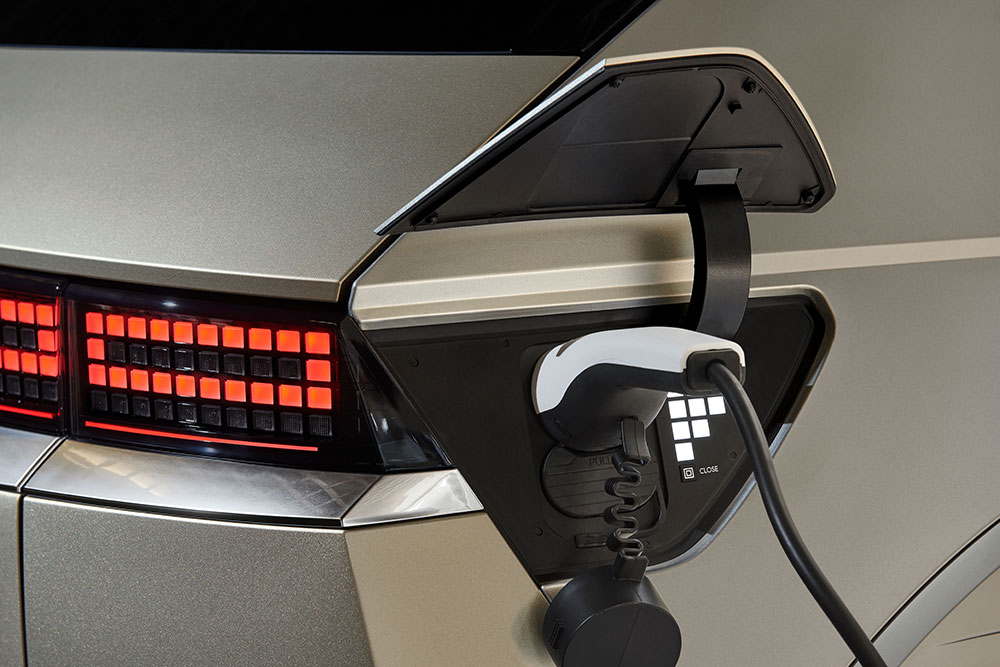Click to buy Hyundai's new EV
.jpg?h=667&iar=0&w=1000&rev=c1dbcd281ace4448ba3b6f05edec4f2d&hash=BD3C17DA7BB083BF8AC4835C19CA388A)
Buyers wanting to secure one of the first examples of Hyundai’s new Ioniq 5 electric vehicles (EVs) will need a good internet connection and a quick mouse hand to secure one, thanks to the Korean car maker embracing an online-only ordering system.
Hyundai has broken plenty of new ground with its new Ioniq 5 EV, including making it available only via an online ordering process, which it describes as a direct-to-customer model.
Priced from $71,900 to $75,900 (MLP) the Ioniq 5 is also Hyundai’s most expensive EV to date and among its most expensive vehicles overall, with only the large seven-seat Palisade Highlander CRDi exceeding its price point.
A statement from Hyundai said: “The sales process has been chosen in light of unprecedented high demand for Ioniq 5 in Australia and limited initial supply.”
The company said the new direct-to-customer sales model aimed to provide a fair allocation to customers across Australia.
Just 400 examples of the Ioniq 5 will be available to Australian consumers in 2021, with a group of 120 potential buyers – who had earlier placed deposits with dealers – given the first opportunity place their order when online ordering opens on 27 September.

Customers who had previously registered their interest in the vehicle will be able to order online on 12 October, ahead of the order books being opened to everyone on 13 October.
The company said it had received an estimated 11,000 expressions of interest for the new model, so the initial allocation of 400 vehicles is going to leave many potential buyers frustrated.
“We’re going to be very much supply limited with the car for the foreseeable future,” said a Hyundai spokesman.
First deliveries of the 2021 batch of 400 units begin in October, with the initial allocation to be delivered to customers through 10 delivery partners chosen from the Hyundai dealer network.
However, after-sales support and servicing will be provided by all 32 Hyundai BlueDrive dealerships across Australia.
Hyundai was quick to point out its new online sales process was unique to the Ioniq 5 and the rest of the Hyundai range – including the Kona and Ioniq EVs – would continue to be sold through the dealership network.
.jpg?h=655&w=1000&rev=2989861f0b624fb090eef6400ae27749&hash=FEF8EC4FEAF8767FB4A9DA06EBD8F3D1)
This was no doubt designed to avoid the sort of negative publicity that plagued Japanese car maker Honda when it moved to a similar direct sales model for all its vehicles earlier this year, forcing the controversial closure of many long-established Honda dealerships.
The futuristic battery-electric medium SUV will initially be offered in a single highly equipped “launch variant” specification, with a choice of 2WD (rear) or AWD powertrains.
Pricing starts from $71,900 (MRLP) for the rear-wheel-drive model, rising to $75,900 (MRLP) for the all-wheel-drive.
Built on Hyundai’s dedicated Electric-Global Modular Platform (E-GMP), Hyundai said the new model made the most of the EV architecture’s design freedoms, with a progressive exterior design, said to be inspired by the mid-70s Hyundai Pony, and a spacious, flexible interior.
The latter features a so-called “Living Space” theme, utilising a versatile sliding island centre console that can be slid fore and aft by up 140mm.
Other features of the hi-tech cabin include a 12.3-inch digital instrument cluster and a 12.3-inch multimedia navigation unit, featuring Android Auto/Apple CarPlay smartphone compatibility and a BOSE eight-speaker premium audio system.
.jpg?h=667&w=1000&rev=dba10e0d0eab4b1d9109a437b76170b5&hash=EABCE0D93D11F446F6DFDC7560890394)
The leather appointed seats are trimmed in what Hyundai calls “sustainable eco-processed leather”, with the slimline front seats featuring 12-way power adjustment and something called a “Relaxion” (zero-gravity) mode, while the rear seats are two-way power-adjustable.
Sustainable materials are used throughout the cabin, including in the seats, headliner, door trim, carpets, and armrests., according to Hyundai.
This includes materials made from recycled PET bottles, plant-based (bio PET) yarns and natural wool yarns, as well as bio paint with plant extracts.
Elsewhere, other luxury features of the launch edition include a heated steering wheel, heated and ventilated front seats, heated rear seats, a vision glass roof with power sunshade and a smart power tailgate.
Safety features extend to seven airbags, including a front-centre side airbag, and an extensive suite of SmartSense advanced active safety and driver assistance technologies.
The exterior design is notable for its daytime running lights (DRLs), which provides a distinctive light signature that is mimicked at the rear of the vehicle.
.jpg?h=655&w=1000&rev=2ba3ece8690b446f889ee6ba02390682&hash=CBDB177AEA73F5680018A68CAAB7F3B0)
Other exterior design features include a “clamshell” bonnet, designed to minimise panel gaps, striking aero-optimised 20-inch alloy wheels, and automatic power operated flush door handles.
Under its skin the Ioniq 5 features a high-voltage 72.6kWh lithium-ion polymer battery, driving either a single, rear-mounted electric motor (rear-wheel drive), or dual rear- and front-mounted electric motors (all-wheel drive).
The single motor unit boasts outputs of 160kW/350Nm, while the dual motor model has combined outputs of 225kW and 605Nm.
The EV boasts world-first ultra-fast 400V and 800V charging capacity, as well as vehicle-to-load (V2L) function, which allows customers to charge electric devices, such as electric bicycles, scooters, camping equipment, or even another electric vehicle.
Standard charging time from 10-80% is just over 6 hours on an AC household plug, about an hour on a 50kW DC fast charger, or a brisk 17 minutes on a 350KW ultra-fast charger.
Consuming 17.9 and 19.0 kWh/100km respectively, the electric range (WLTP) of the 2WD single motor is 451km, while the dual-motor all-wheel-drive is 430km.
Top speed is 186km/h for both models, with the 2WD covering the 0-100km/h spring in 7.4 seconds and the dual motor in a rapid 5.2 seconds.
Related topics
Things to note
The information in this article has been prepared for general information purposes only and is not intended as legal advice or specific advice to any particular person. Any advice contained in the document is general advice, not intended as legal advice or professional advice and does not take into account any person’s particular circumstances. Before acting on anything based on this advice you should consider its appropriateness to you, having regard to your objectives and needs.
Insurance Products (excluding Travel Insurance) are issued by RACQ Insurance Limited ABN 50 009 704 152 (RACQI) and arranged by its agent, RACQ Distribution Services Pty Ltd (RDS) ABN 35 116 361 650, AFSL 567130 and RDS' authorised representatives (including RACQ Operations Pty Ltd ABN 80 009 663 414, AR No. 234978 (RACQO). Conditions, limits and exclusions apply. RDS and RACQO are in the RACQ group of companies. One of the companies in the RACQ group of companies has a minority shareholding in RACQI.
RDS and RACQO have not taken your personal objectives, circumstances or needs into account when preparing advice regarding insurance products and you will need to consider whether the advice is appropriate for you. Read the Product Disclosure Statement (PDS) and any applicable Supplementary PDS before making a purchase decision on this product. You can also access our Target Market Determinations on this website. RDS receives a commission from RACQI for the policies it arranges. RACQO receives fees paid for services it provides to RDS. Further details about remuneration are available on request prior to purchasing.
Banking and loan products issued by Members Banking Group Limited ABN 83 087 651 054 AFSL/Australian credit licence 241195 trading as RACQ Bank. Terms, conditions, fees, charges and lending policies apply. This is general advice only and may not be right for you. This information does not take your personal objectives, circumstances or needs into account. Read the disclosure documents for your selected product or service, including the Financial Services Guide and the Terms and Conditions, and consider if appropriate for you before deciding.
Except for RACQ Bank, any RACQ entity referred to on this page is not an authorised deposit-taking institution for the purposes of the Banking Act 1959 (Cth). That entity’s obligations do not represent deposits or other liabilities of RACQ Bank. RACQ Bank does not guarantee or otherwise provide assurance in respect of the obligations of that entity, unless noted otherwise.
RACQ Bank subscribes to the Customer Owned Banking Code of Practice which establishes higher standards than the law requires. The Code reflects modern consumer expectations and developments in approaches to issues such as consumer vulnerability, guarantors, and supporting customers through financial hardship. Please read our Customer Owned Banking Code of Practice page for more information.
RACQ Operations Pty Ltd (ABN 80 009 663 414 AR 000234978) and Members Travel Group Pty Ltd (ABN 45 144 538 803 AR 000432492) are acting as an Authorised Representative of the issuer of the insurance, Tokio Marine & Nichido Fire Insurance Co., Ltd. (ABN 80 000 438 291 AFSL 246 548). Any advice set out above is general in nature only, and does not take into account your objectives, financial situation or needs. Before purchasing any travel products, please consider the RACQ Travel Insurance Product Disclosure Statement (PDS) and the Target Market Determinations (TMDs) that apply to these products. Whilst the PDS outlines the Terms and Conditions of these products, the TMDs outline the intended class of customers that comprise the target market for these travel products. This will allow you to consider which products best suit your objectives, financial situation and needs and consider the products appropriateness to your personal circumstances. TMDs also outline matters involving the distribution and the review of these products. The PDS, Supplementary PDS and TMDs for each travel product can be found here.

